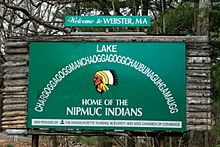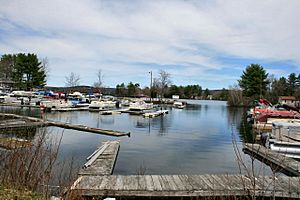Chaubunagungamaug Nipmuck facts for kids
 |
|
| Total population | |
|---|---|
| 354 (2002). | |
| Regions with significant populations | |
| United States of America |
|
| Languages | |
| English, Nipmuck, Massachusett | |
| Religion | |
| Christianity, Midewiwin (Manito), Other. | |
| Related ethnic groups | |
| Other Nipmuc(k) tribes, Massachusett, Wampanoag, Narragansett, Pennacook, Pocomtuc, Pequot, Mohegan and other Algonquian peoples |
The Webster/Dudley Band of the Chaubunagungamaug Nipmuck Indians is a Native American tribe. They are also known as the Chaubunagungamaug, Chaubunagungamaug Nipmuck, Pegan or Dudley Indians. This tribe is native to the states of Massachusetts and Connecticut in New England.
They are one of three tribes in Massachusetts that the state officially recognizes. The other two are the Hassanamisco Nipmuc and the Natick Massachusett. The Natick Massachusett are mostly from the Massachusett people.
The tribe's ancestors lived between Lake Chaubunagungamaug and the Maanexit River. English settlers first met them in the 1630s. This was when colonists followed Indian trails to new areas or during the Pequot War (1634-1638). By the 1670s, the Chaubunagungamaug Nipmuck were under the control of the Massachusetts Bay Colony. They were also influenced by missionary Rev. John Eliot. This led to the creation of a 'Praying Town of Chabanakongkomun' in 1674.
After King Philip's War (1675-1676), the Chaubunagungamaug Nipmuck received a reservation in 1682. This land was sold in 1870. This happened after the Massachusetts Indian Enfranchisement Act was passed. The tribe had to spread out and join the nearby communities.
The tribe officially formed in 1981. They then received state recognition from the Massachusetts Commission on Indian Affairs. The tribe uses private land in Webster, Massachusetts and Thompson, Connecticut as their unofficial reservation. They worked closely with the Hassanamisco Nipmuc under Nipmuc Nation to gain federal recognition. However, the tribe left Nipmuc Nation in 1996. Many Chaubunagungamaug Nipmuck still connect with Nipmuc Nation. They are counted among the Hassanamisco Nipmuc. The Bureau of Indian Affairs denied the tribe federal recognition in 2001, 2004, and 2007.
Contents
What Does Their Name Mean?
The Chaubunagungamaug Nipmuck prefer to use 'Nipmuck' instead of 'Nipmuc'. Both spellings have been used for a long time. They come from the word nippamaug, which means 'freshwater fishing pond'. This is similar to words in the Massachusett language. For example, nippa- means 'freshwater' and -âmaug means 'fishing pond'.
Chaubunagungamaug is one of two Native names for Webster Lake. This lake is a big part of the southern half of the town. The name means 'divided fishing place' or 'fishing place at the boundary'. The lake was once split into special fishing areas. The Nipmuck lived in a village called Chabunagungamag at the north end. Another Nipmuck group lived at Monuhchogok (Manchaug) to the south. The lake's full name is Chargoggagoggmanchauggagoggchaubunagungamaugg. It includes words like chapun- meaning 'to divide' and -âmaug meaning 'fishing pond'. John Eliot used a different spelling, Chabonakongkomun, for the Praying Town near the old village.
For most of the 1700s, the Nipmuck of Chaubunagungamaug were called the Pegan Indians. This was because many members had the last name Pegan. Many of them had family ties to Natick. The word pegan- or pahegan- means 'clear'. It can mean something cut down to let light through, or 'bare' or 'treeless'. It is similar to the Massachusett word pohk- which means 'clear'.
English settlers often called the Nipmuck near the lake by the name of their reservation. As Praying Indians, they were first known as the Praying Indians of Chabanakongkomun. The reservation lands were in the town of Dudley, Massachusetts. Later, part of this land became the town of Webster, Massachusetts. So, they were known as the Dudley, Webster-Dudley, Dudley-Webster and Webster Indians. In 1996, the tribe officially chose the name Webster/Dudley Band of the Chaubunagungamaug Nipmuck Indians.
Where They Live
The Nipmuck homeland was called Nippenet. This means 'freshwater (pond) place'. This area has many small ponds and lakes. It covers most of central Massachusetts and parts of north-eastern Connecticut and north-western Rhode Island.
The Chaubunagungamaug lived mainly between Lake Chaubunagungamaug and the Maanexit River. This area includes the towns of Dudley, Southbridge, Webster, Charlton, Oxford, Sutton, and Douglas in southern Worcester County, Massachusetts. It also includes the town of Thompson in Windham County, Connecticut.
Their main village, Chaubunagungamaug, was north of the lake in what is now Webster. The reservation lands became smaller and were surrounded by the town of Dudley. Later, the reservation lands were moved back to the area around the lake. This area then became the town of Webster. A few acres there are still used by the tribe as their reservation.
Who Can Be a Member?
To be a member of the tribe, you must be a direct descendant of the 'Dudley Indians'. These were listed in the 1861 Report to the Governor and Council concerning the Indians of the Commonwealth (Earle Report). This report was made by Indian Commissioner John Milton Earle. You can also be a descendant of those listed in the 1890 Worcester Probate Court lists. These lists showed who received money from the sale of reservation land.
Some family names of Dudley Indians from the 1861 Earle Report include Bakeman, Beaumont, Belden, Cady, Corbin, Daley, Dorus, Esau, Fiske, Freeman, Henry, Hull, Humphrey, Jaha, Kyle, Nichols, Oliver, Pegan, Robinson, Shelley, Sprague, White, Willard and Williard. In 2004, the tribe had 354 members.
In 2004, 277 members of the Nipmuc Nation were Chaubunagungamaug Nipmuck. These members stayed with the Nipmuc Nation after the Webster/Dudley Band left in 1996. Most of them were from the Jaha, Humphrey, Belden, Pegan/Wilson, Pegan, and Sprague families. This also meant that 43% of all known descendants of the Dudley Indians were not on tribal lists at that time.
How the Tribe is Governed
Since 1981, the tribe has been led by the descendants of Sachem ('Chief') Edwin Wise Owl Morse, Sr. He was the one who officially formed the Chaubunagungamaug Nipmuck. Today, the tribe is led by Sachem Edwin Morse III.
Since 1996, the tribe has its own elected council. Council members are elected for three-year terms. Elections happen at the end of December. As of November 2013, the council included Chairman/Treasurer Kenneth White, Vice-Chairman David White, Secretary Sherry Davis, Enrollment Committee Chairperson Stacey Kelleher, Resident Agent Tom Morse, Claudia Zatorski, Barbi Gardiner, and Melissa Greene. Council members must come from certain family lines, such as the Dorus/White, Sprague/Henries, and Nichols/Heath families.
Sachems (Chiefs) since 1981
- Sachem Edwin Wise Owl Morse, Sr., from 1981 to 2010.
- Sachem Edwin Red Fox Morse, Jr., from 2010 to 2013.
- Sachem Edwin Spring Fox Morse III, from 2013 to today.
Working with Other Nipmuck Tribes
The Webster/Dudley Band of the Chaubunagungamaug Nipmuck and the Hassanamisco Nipmuc (including Nipmuc Nation Chaubunagungamaug Nipmuck) used to have disagreements. However, their close family ties and shared cultural interests have helped them become closer. The two tribes are now working together to bring back the Nipmuck language. They are also involved in projects like Project Mishoon, which is about archaeological work. They hope to use land identified by the East Quabbin Land trust for a Nipmuck cultural center.
Other Nipmuck groups that are not recognized by the state include the Connecticut Nipmuck. These are descendants of Nipmuck from the Praying towns in Connecticut. They also include Nipmuck who moved there. There are also the Quinsigamond Nipmuck. This group includes many Nipmuck who are descendants of the original Quinsigamond Nipmuck. It also includes those who later moved to the areas around Worcester, Massachusetts. Nippamaug from all bands often go to each other's powwows, Indian fairs, and social gatherings. The Chaubunagungamaug Nipmuck, Hassanamisco Nipmuc, and Natick Massachusett are state-recognized tribes in Massachusetts. They work with the Massachusetts Commission on Indian Affairs to support Native peoples.
Important Chaubunagungamaug Nipmuck People
Chiefs and Leaders
- Sachem Willymachin 'Black James,' a Chief in the 1600s.
- Sachem James, son of Willymachin and brother to Simon, a Chief in the 1600s.
- Sachem Simon, son of Willymachin and brother to James, a Chief in the 1600s.
- Joseph, Teacher of the Praying Town of Chabanakongkomun, son of Hassanamisco Nipmuck Sachem Robin Petahvit, in the 1600s.
- Sachem Edwin Wise Owl Morse, Sr., Chief from 1981 to 2010.
- Sachem Edwin Red Fox Morse, Jr., Chief from 2010 to 2013.
- Sachem Edwin Spring Fox Morse III, the current Chief.
- David Tall Pine White, Tribal councilor, language teacher, and language consultant/actor on the We Shall Remain mini-series.
Veterans
- Joshua Ephraim, fought in the American Revolutionary War, 1700s.
- Eleazer Pegan, fought in the American Revolutionary War, 1700s.
- Josiah Pegan, fought in the American Revolutionary War, 1700s.
- Joseph Pegan, Jr., fought in the American Revolutionary War, 1700s.
- Josiah Pegun, fought in the American Revolutionary War, 1700s.
- Hezekiah Dorus, fought in the Civil War, 1800s.
- Joseph E. Bowman, fought in the Civil War, 1800s.
- William H. Cady, fought in the Civil War, 1800s.
- Joseph H. P. White, fought in the Civil War, 1800s.
- James M. Pegan, fought in the Civil War, 1800s.
- Theophilus D. Freeman, fought in the Civil War, 1800s.
- Israel Henries, fought in World War I, 1900s.
- Earl Edward Henries, drafted for World War II, 1900s.
See also
 In Spanish: Nipmuck para niños
In Spanish: Nipmuck para niños


